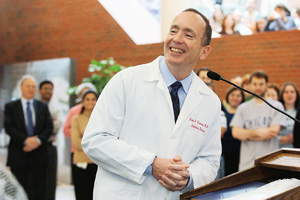

Medical Center
Fighting the Flu

ANNOUNCING EXCELLENCE: John Treanor, principal investigator for Rochester’s newly awarded New York Influenza Center for Excellence, outlined the center’s goals at a press conference this spring.
Rochester launches new $26 million center to research and combat pandemic flu. By Greg Williams
There’s a lot at stake in understanding exactly why the viruses that cause bird flu are so effective at triggering mayhem in the human immune system, says John Treanor ’79M (MD) as he prepares to lead one of the nation’s most prominent centers for the study of pandemic flu.
“Anything that we do—any progress that we can make in understanding pandemic influenza—will have a direct payoff for seasonal influenza,” says Treanor, a professor of medicine and director of the Vaccine Treatment and Evaluation Unit at the Medical Center. More than that, he notes, ”We expect to learn things about human immunity that may translate to our understanding of other diseases and suggest new approaches for research in other areas as well.”
Thanks to a $26 million award from the National Institute of Allergy and Infectious Diseases, this spring Rochester became home to the New York Influenza Center for Excellence, a seven-year collaborative effort between the University, Cornell University, the University of Tennessee at Knoxville, and community partners. Headed by Treanor and David Topham, an associate professor of microbiology and immunology at the Medical Center, the new center is one of six nationally that together will receive approximately $138 million in new flu research funding.
The centers will focus on basic research, surveillance studies, or both. Teams will break down the molecular and environmental factors that influence the transmission and evolution of flu viruses and study the immune system’s reaction to them. Others will seek to identify strains with pandemic potential, to create new vaccine candidates, or to bolster pandemic preparedness.
“The current strategy of relying on vaccines that match each year’s particular strain imposes severe limitations on our ability to prepare for a pandemic,” says Treanor. “Our goal is to transform our understanding of influenza through intensive and synergistic exploration of the virus, the human host, and the immune system. We hope that this will lead to more effective control of the viruses through a single vaccine that can be effective against many strains.”
Researchers will follow college students, healthy adults, and 150 families with young children in the Rochester area for seven years, monitoring them for exposure to flu and responses to vaccination. All data will be captured and shared through an NIH database.
Despite new technologies developed since the pandemic flu of 1918 killed 50 million people worldwide, flu remains the most common cause of vaccine-preventable death in the United States, causing 40,000 deaths annually and up to 150,000 hospital stays. The H5N1 subtype of avian flu viruses responsible for recent outbreaks of bird flu continues to spread with migrating waterfowl, increasing the risk of bird-to-human infection and the chance that the virus will become more easily passed from person to person.
“Our goal is to better understand the human immune response to vaccination and infection so that we can improve vaccines against emerging influenza viruses, like the bird flu, that pose the risk of causing a pandemic,” says Topham. “The need to make a new vaccine each year puts enormous strain on our ability to provide adequate amounts in a timely fashion and vaccine shortages, not stockpiles, are the result. The new centers hope to answer urgent questions, and ultimately, to save lives.”
